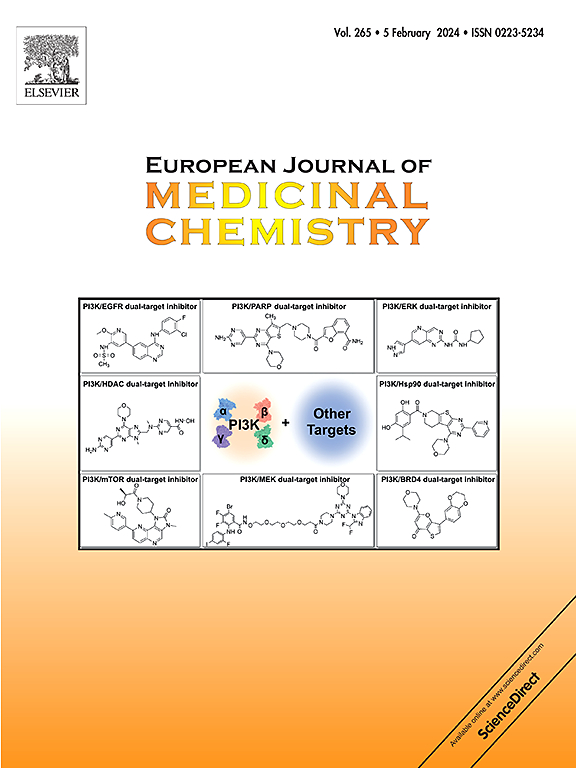通过选择性靶向血红素加氧酶-1,发现抑制巨噬细胞极化、对抗类风湿性关节炎的西奈梅宁衍生物
IF 6
2区 医学
Q1 CHEMISTRY, MEDICINAL
引用次数: 0
摘要
青藤碱(SIN)在临床上可用于治疗类风湿性关节炎(RA),但其副作用限制了其临床应用。在这项研究中,我们设计并合成了含有新型环片段的SIN衍生物,并评估了巨噬细胞的生物活性。在这些化合物中,与其他衍生物相比,sin14对炎症介质产生的抑制作用明显更强,诱导巨噬细胞从M1表型向M2表型极化。通过热蛋白质组分析(TPP),我们证明了SIN 14特异性靶向血红素加氧酶1 (HO-1),并通过变构机制诱导其激活。特别是,SIN 14表现出远端螺旋和表面暴露环(cd环),促进底物结合和产物释放,最终导致抗炎代谢物的释放。在体内,sin14可以抑制胶原诱导关节炎(CIA)小鼠ra相关炎性水肿。采用单细胞RNA转录组测序技术研究了sin14处理后CIA小鼠的细胞和转录格局。这些结果表明,sin14降低了巨噬细胞的M1/M2极化比,从而减轻了滑膜组织炎症的严重程度。综上所述,我们的研究确定了SIN 14是抗ra药物发现的有希望的候选者。此外,我们强调HO-1是RA治疗的独特细胞靶点。本文章由计算机程序翻译,如有差异,请以英文原文为准。

Discovery of sinomenine derivatives inhibiting macrophage polarization against rheumatoid arthritis through selectively targeting heme oxygenase-1
Sinomenine (SIN) is clinically available for the treatment of rheumatoid arthritis (RA), but the side effects of SIN limit clinical applications. In this study, we designed and synthesized SIN derivatives that incorporated a novel ring fragment and assessed bioactivities in macrophages. Among the compounds, SIN 14 exhibited significantly more potent inhibitory effects on inflammatory mediator production compared to the other derivatives, which induced macrophage polarization from M1 to M2 phenotype. Through thermal proteome profiling (TPP), we demonstrated that SIN 14 specifically targeted heme oxygenase 1 (HO-1) and induced the activation through an allosteric mechanism. In particular, SIN 14 exhibited the distal helix and the surface-exposed loop (CD-loop), which facilitates substrate binding and product release, ultimately leading to the liberation of anti-inflammatory metabolites. In vivo, SIN 14 could inhibit RA-related inflammatory edema in collagen-induced arthritis (CIA) mice. Single-cell RNA transcriptome sequencing was employed to elucidate the cellular and transcriptional landscape in CIA mice after SIN 14 treatment. These results indicated that SIN 14 reduced the M1/M2 polarization ratio of macrophages, thereby alleviating the severity of inflammation in synovial tissues. Taken together, our study identifies SIN 14 as a promising candidate for anti-RA drug discovery. Furthermore, we emphasize HO-1 as a distinctive cellular target for RA therapy.
求助全文
通过发布文献求助,成功后即可免费获取论文全文。
去求助
来源期刊
CiteScore
11.70
自引率
9.00%
发文量
863
审稿时长
29 days
期刊介绍:
The European Journal of Medicinal Chemistry is a global journal that publishes studies on all aspects of medicinal chemistry. It provides a medium for publication of original papers and also welcomes critical review papers.
A typical paper would report on the organic synthesis, characterization and pharmacological evaluation of compounds. Other topics of interest are drug design, QSAR, molecular modeling, drug-receptor interactions, molecular aspects of drug metabolism, prodrug synthesis and drug targeting. The journal expects manuscripts to present the rational for a study, provide insight into the design of compounds or understanding of mechanism, or clarify the targets.

 求助内容:
求助内容: 应助结果提醒方式:
应助结果提醒方式:


